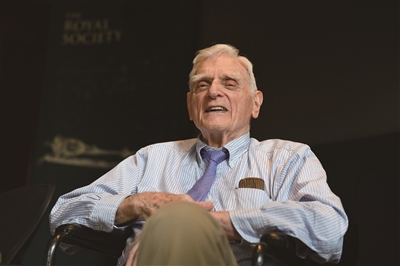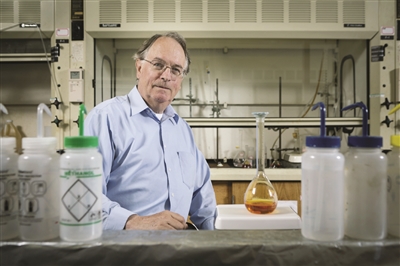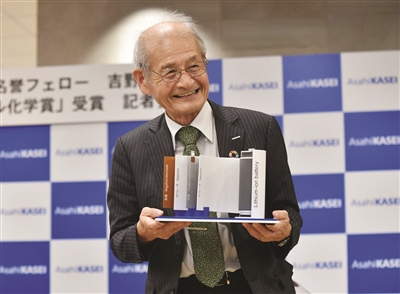
John Goodenough (American, born in 1922)

Stanley Whittingham (American, born in 1941)

Akira Yoshino (Japan, born in 1948)
The 2019 Nobel Prize in Chemistry was awarded to American solid-state physicists John Goodenough, Stanley Whittingham and Japanese chemist Akira Yoshino in recognition of their contributions in the field of lithium batteries. The three scientists will share the prize of 9 million Swedish kronor (about 910 thousand US dollars) equally.
The reporter interviewed many professors from Nanjing University and Nanjing University of Technology. All the professors interviewed were unanimous: the three professors were well-deserved, especially the 97-year-old American solid-state physicist John Goodenough. "We all think that he should have won this award long ago."
He set a new record for the oldest person.
Haruki Murakami in the scientific community: 97 years old, working every day.
This year’s Nobel Prize in Chemistry, besides the winning project "People-friendly", another highlight is Goodenough, a 97-year-old award-winning scientist. Previously, this record was held by arthur ashe King, an American scientist who won the 2018 Nobel Prize in Physics at the age of 96. Because of Goodenough in the name (meaning "good enough"), Goodenough was also humorously called "good enough" by the outside world.
For many years in a row, the "good enough" old man has been nominated, but he has been in a state of running with him. "Everyone thinks that the old man should have won this award long ago." Zhu Jixin, a professor at the Institute of Advanced Materials of Nanjing University of Technology, said that Goodenough has been nominated for the Nobel Prize many times, which is almost the "Haruki Murakami" in the scientific circle.
Previously, Goodenough has made outstanding contributions in the field of magnetic materials. For him at that time, electrochemistry belonged to the nature of "playing with tickets". "Early batteries had low discharge capacity and energy storage density. Goodenough found lithium cobaltate with layered structure as the anode of the battery, and used metal materials other than lithium as the anode, which can realize high-density energy storage. " In this way, rechargeable lithium batteries can be commercialized.
Now, the "good enough" old man who is over 90 years old still goes to work in the small office of the University of Texas at Austin every day. To this, he explained, "My work is not finished yet."
"Good enough" in Professor Nanjing’s eyes: All-rounder in arts and sciences with high output, especially loving home.
Many professors interviewed by this reporter are no strangers to Goodenough. Professor Jin Zhong from the School of Chemistry and Chemical Engineering of Nanjing University told the reporter that Mr. Good enough is still studying new energy storage battery systems, especially high-safety solid-state lithium batteries, which maintain high-quality scientific research output every year. At some meetings, there is no lack of him. "He is very kind and approachable. He has many new ideas and has been breaking through himself. When he speaks the report, the organization is very clear. The articles he writes not only put forward new concepts, but also explain the principles very clearly. " Admiralty said that he has also taught a group of masters of making batteries, and his disciples are all in academia and industry.
In academic circles, Goodenough’s "all-rounder" is also famous. From philosophy and other liberal arts disciplines to lithium battery research and other fields of science and engineering, Goodenough’s learning and scientific research stories across the liberal arts and sciences have become the benchmark for future generations to marvel at. Professor Zhou Haoshen from the Department of Energy, School of Modern Engineering and Applied Science, Nanjing University, told the reporter that Goodenough was still a "special family lover" and his life was very warm.
prize motivation
They make the use of lithium batteries "good enough"
"The Nobel Prize in Chemistry was awarded to three scientists, which gave a shot in the arm to the new energy field that has not won awards for many years." Professor Jin Zhong of Nanda University said that the Nobel Prize in Chemistry has been awarded to research in biochemistry and other fields for two consecutive years. This time, Mr. "Good enough" won the prize at the age of 97, which can be said to be widely expected. The award-winning research on lithium-ion batteries is a systematic research with traditional electrochemistry as the core and involving physics, chemistry, energy and materials.
A Professor Hao Shen from Nanda Zhou introduced that the early nickel-cadmium batteries and lead-acid batteries had low energy density. In 1970s, Stanley Whittingham, one of the winners of the 2019 Nobel Prize, made the world’s first new lithium-ion battery with titanium sulfide as the cathode material and lithium metal as the cathode material.
B This is undoubtedly a great progress of mobile power supply, but it has a lot of hidden dangers, because lithium metal is active, so the battery will be in danger of explosion. In order to solve this problem, Goodenough predicted that if the positive electrode was made of a metal oxide containing lithium instead of a metal sulfide, the battery would have a greater potential. In 1980, Goodenough invented the most important component in lithium batteries, lithium cobaltate cathode material. Nowadays, most portable electronic devices all over the world use this cathode material.
C Since then, Japanese scientist Akira Yoshino has discovered that the negative electrode can be made of carbon material and does not contain any metal. Matching the positive electrode discovered by Goodenough, he invented the first commercially feasible lithium-ion battery in 1990. Instead of using metallic lithium as the cathode, he used graphite, a carbon material that can insert lithium ions like lithium cobaltate as the cathode.
In 1991, the lithium-ion battery jointly invented by Akira Yoshino and Goodenough was put on the market by Sony, which marked the large-scale use of lithium-ion batteries. The original brick-like "mobile phone" no longer exists, and it is replaced by a thin mobile phone that uses lithium batteries and "slim down" the parts together.
At present, both electric vehicle technology and mobile electronic technology are based on the vigorous development of lithium batteries, which makes our life "good enough".
How to solve the problem of battery spontaneous combustion and slow charging?
"Super Battery" is on its way.
The cooperation between Akira Yoshino and Goodenough has made the lithium battery with high explosion risk safe, but readers will surely ask, why do the news of spontaneous combustion or explosion of mobile phone batteries still occasionally appear in newspapers? Admiralty explained that the fire and burning accidents of mobile phones and electric vehicles will be reported every once in a while in the news, precisely because the safety of lithium batteries is still not satisfactory. It can be said that people are still not completely satisfied with the performance of lithium-ion batteries, and further technological innovation is needed to develop a battery with high energy density, good safety, long cycle life and no pollution to the environment, which is exactly what people are looking forward to.
In addition, our common "complaints" about the lack of fast charging and large capacity of lithium batteries are also the future development direction of lithium batteries. Zhou Haoshen said that the "technological revolution" of lithium batteries is still on the road, and there are three main innovations: the energy density, power density and safety factor of batteries should be made higher. But there is a problem that you can’t have your cake and eat it. Therefore, Goodenough, a 97-year-old "good enough" old man, still insists on the front line of scientific research, just to solve these problems. Perhaps in the future, "super battery" will be successfully born, and new electrons with high energy density, such as lithium air battery, metal battery and lithium sulfur battery, will better change our lives.
A doctor from NTU has just become a "good enough" postdoctoral fellow.
In Nanjing University Institute of Technology, Zhou Haoshen’s lithium battery research group specializes in the research of new electrochemical energy storage materials and technologies, including lithium-ion batteries, and keeps in communication with Goodenough’s research group.
The reporter learned that a doctor who graduated from Nantah Institute of Technology also successfully applied for a postdoctoral position in Goodenough’s research group, officially went to the United States in September this year and began to follow Professor Goodenough as a postdoctoral position. Professor Zhou Haoshen revealed, "Yesterday, the postdoctoral fellow was still with ‘ Good enough ’ The old man discussed the work of NTU solid lithium air battery and agreed to cooperate. " (Yangzi Evening News/Zi Niu News reporter Yang Tianzi)
关于作者